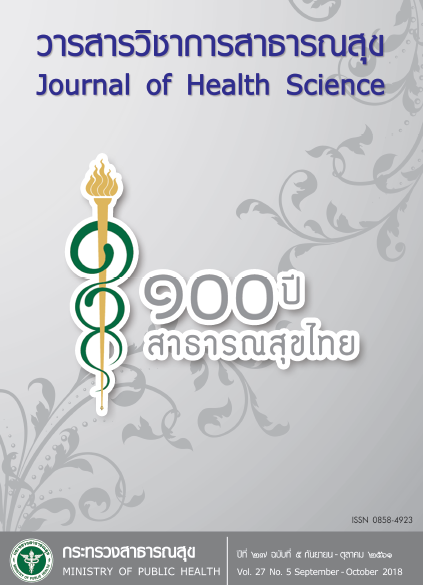Development of a Home Care Model for Stroke Patients through1A4C toward Activity Day Living
Keywords:
home care model for stroke patients, 1A4C, activity day livingAbstract
The purposes of this participatory action research were to study the development of a home care model using 1A4C approach to improve the activity daily living of stroke pateints among Khmu, Tai Lue, Hao and Lua ethnic groups who attended the Pon District Health Promoting Hospitals in Pon and Thungchang district, Nan province. It was conducted between January - December 2015. The sample were 7 stroke patients and 48 care givers, altogether 55 of them (19 Khmu, 14 Tai Lue, 14 Hao and 8 Lua). The tools and instruments for data collection were Barthel Activity of Daily Living Index, perceived value form, satisfaction assessment form, and stress questionnaire form; and the data were analyzed by analytic induc-tion method. The components of the 1A4C home care model for stroke patients included (1) accessibility: through volunteer interpreter, phone number attached to every house, and referral by subdistrict adminis-trative organization; (2) continuity: forwarding data by home care-taker to volunteers to inform the family care team who would perform home visites; (3) comprehensiveness: following religious norm in their rituals; (4) co–ordination: coordinating care with traditional healers; (5) community participation: local community leaders submitting patient data to gain support by social development and human security authority, and using innovative local wisdom to assist patient rehabilitation. It was found that the model could help 5 ethnic patients getting access to primary care services, resulting in significant physical im-provement. Key success factors were accessibility to health services within 14 days and close home care by care givers and volumteers. There were 2 patients with delayed improvement due to the adherence of traditional rituals and refusal of care. After participating the stroke home care model, 5 patients (71.43%) were able to improve their quality of life and return to mild dependence level; and significant reduction of stress among the relatives was observed. The model was also found to achieve high level of satisfaction among the patients and their relatives; and to reduce the trasportation cost of 2,000 baht per case. In conclusion, the stroke home care model using 1A4C approach was effective in improving activity daily living of the ethnic patients. It should be scaled-up to cover other health facilities providing services to the same ethnic populations.
Downloads
Downloads
Published
How to Cite
Issue
Section
License
Copyright (c) 2018 Journal of Health Science- วารสารวิชาการสาธารณสุข

This work is licensed under a Creative Commons Attribution-NonCommercial-NoDerivatives 4.0 International License.







